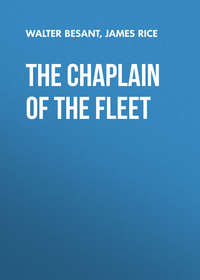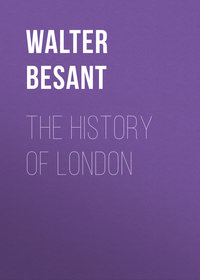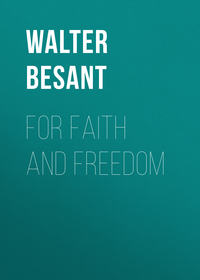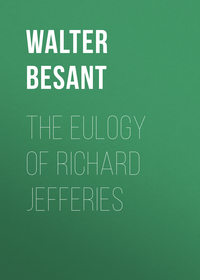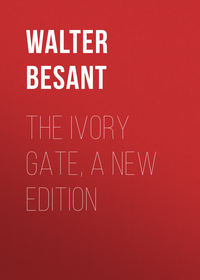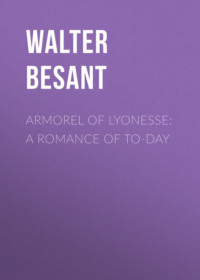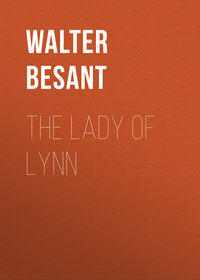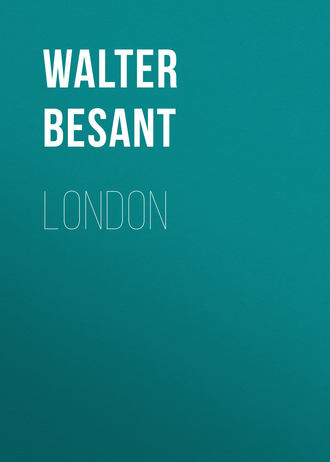 полная версия
полная версияLondon
The Mystery is over; the people have all gone away; the stage is removed, and the church is empty again. Two priests are left, and their talk is like a jarring note after sweet music. "Brother," says one, "were it not for such shows as these, if we did not present to the people the things which belong to religion in such a way that the dullest can understand, the Church would be in a parlous way. All folk cry out upon the profligacy of the monks, and their luxury, and the greed of the priests. What sayeth Walter Map, that good archdeacon?
"'Omnis a clericis fluit enormitas,Cum Deo debeant mentes sollicitas,Tractant negotia mercesque vetitasEt rerum turpium vices indebitas.'""I hear," said the other, "that two Cistercians have lately become apostate to the Jews."
"Rather," replied the first, "they should have become Christians, so to separate themselves the better from that accursed body."
These are the distant rumblings of the gathering storm. But the Church will become much richer, much more powerful, the monks will become much more profligate, the priests will become far more greedy before things grow to be intolerable.
It is an evening in May. What means this procession? Here comes a sturdy rogue marching along valiantly, blowing pipe and beating tabor. After him, a rabble rout of lads and young men, wearing flowers in their caps, and bearing branches and singing lustily. This is what they sing, not quite in these words, but very nearly:
Sumer is icumen in,Lhude sing cuccu!Groweth sed and bloweth med,And springth the wde nu.Sing cuccu.Awe bleteth after lamb,Llouth after calve cu,Bulluc sterteth, buck verteth,Murie sing cuccu!Cuccu, cuccu, well singeth thu cuccu,Ne swik thu navu nu;Sing cuccu, cuccu, nu sing cuccu,Sing cuccu, sing cuccu, nu!The workman jumps up and shouts as they go past; the priest and the friar laugh and shout; the girls, gathering together as is the maidens' way, laugh and clap their hands. The young men sing as they go and dance as they sing. Spring has come back again – sing cuckoo; the days of light and warmth – sing cuckoo; the time of feasting and of love – sing cuckoo. The proud abbot, with his following, draws rein to let them pass, and laughs to see them; he is, you see, a man first and a monk afterwards. In the gateway of his great house stands the Norman earl with his livery. He waits to let the London youth go by. The earl scorns the English youth no longer; he knows their lustihood. He can even understand their speech. He sends out largesse to the lads to be spent in the good wines of Gascony and of Spain; he joins in the singing; he waves his hand, a brotherly hand, as the floral greenery passes along; he sings with them at the top of his voice:
Sing cuccu – cuccu – nu sing cuccu;Sing cuccu; sing cuccu, nu.Presently the evening falls. It is light till past eight; the days are long. At nightfall, in summer, the people go to bed. In the great houses they assemble in the hall; in winter they would listen to music and the telling of stories, even the legends of King Arthur. Walter Map7 will collect them and arrange them, and the French romances, such as "Amis et Amils," "Aucassin et Nicolette," though these have not yet been written down. In summer they have music before they go to bed. We are in a city that has always been fond of music. The noise of crowd and pipe, tabor and cithern, is now silent in the streets. Rich men kept their own musicians. What said Bishop Grossetête?
Next hys chamber, besyde hys study,Hys harper's chamber was fast ther by,Many tymes, by nightes and dayes,He hade solace of notes and layes.One asked him the resun whyHe hadde delyte in minstrelsy?He answered hym on thys manereWhy he helde the harpe so dere:The virtu of the harpe thurh skill and rightWyll destrye the fendys myght,And to the cros by gode skeylYs the harpe lykened weyl.He who looks and listens for the voice of the people in these ancient times hears no more than a confused murmur: one sees a swarm working like ants; a bell rings: they knock off work; another bell: they run together; they shout; they wave their hats; the listener, however, hears no words. It is difficult in any age – even in the present day – to learn or understand what the bas peuple think and what they desire. They want few things indeed in every generation; only, as I said above, the three elements of freedom, health, and just pay. Give them these three and they will grumble no longer. When a poet puts one of them on his stage and makes him act and makes him speak, we learn the multitude from the type. Later on, after Chaucer and Piers Ploughman have spoken, we know the people better; as yet we guess at them, we do not even know them in part. Observe, however, one thing about London – a thing of great significance. When there is a Jacquerie, when the people, who have hitherto been as silent as the patient ox, rise with a wild roar of rage, it is not in London. Here men have learned – however imperfectly – the lesson that only by combination of all for the general welfare is the common weal advanced. I think, also, that London men, even those on the lowest levels, have always known very well that their humility of place is due to their own lack of purpose and self-restraint. The air of London has always been charged with the traditions and histories of those who have raised themselves; there never has been a city more generous to her children, more ready to hold out a helping hand; this we shall see illustrated later on; at present all is beginning. The elementary three conditions are felt, but not yet put into words.
We are at present in the boyhood of a city which after a thousand years is still in its strong and vigorous manhood, showing no sign, not the least sign, of senility or decay. Rather does it appear like a city in its first spring of eager youth. But the real work for Saxon and Norman London lies before. It is to come. It is a work which is to be the making of Great Britain and of America, Australia, and the Isles. It is the work of building up, defending, and consolidating the liberties of the Anglo-Saxon race.
They were not wretched at all, these early London citizens; but, on the contrary, joyous and happy and hopeful. And not only for the reasons already stated, but for the great fact – the greatest fact of the time – of their blind and unreasoning faith. It is impossible to exaggerate the importance of unreasoning faith as a factor in human happiness. The life of the meanest man was full of dignity and of splendor, because of the great inheritance assured to him by the Church. We must never leave out the Church in speaking of the past. We must never forget that all people, save here and there a doubting Rufus or a questioning Prince of Anjou, believed without the shadow of any doubt. Knowledge brought the power of questioning. As yet there was no knowledge. Therefore every man's life, however miserable, was, to his happy ignorance, the certain ante-room of heaven. We are fond of dwelling on the mediæval hell, the stupidity and the brutality of its endless torture, and the selfishness of buying salvation by masses. Hell, my friends, was always meant for the other man. He who saw the devils painted on the church-wall, rending, tearing, frying, cutting, burning the poor souls in hell, knew these souls for those of his enemies. Like Dante, he saw among them all his public and his private foes. He looked upward for his hope. There he beheld loving angels bearing aloft in their soft arms the soul redeemed to the abode of perfect bliss. In that soul he recognized himself; he saw the portraiture, exact and lifelike, of his own features.
When the ambassadors of the Caliph Haroun al Raschid brought gifts to the great King Karl, the finest thing he had to show them was the splendid service of the Church.
This story is told literally. It might be told as an allegory. In London Saxon and Norman, as also for many centuries to follow, the finest thing they had to show was the Church, with its music that moved the heart to tears; its promises, which steeled the soul to endurance; its glories, which carried the beholder far away from the wattle and clay of his hut and his grimy leathern doublet; its frown, which stood between him and the tyrannous Over Lord, and saved his home from starvation and his womankind from dishonor. Fortunate was it for the people that they had the Church to show to those ambassadors of the Moslem.
III
PLANTAGENET
I. ECCLESIASTICALPrince Pantagruel and his companions, pursuing their incomparable voyage, sailed three days and three nights without discovering anything, and on the fourth day made land. The Pilot told them that it was the Ringing Island; and, indeed, they heard afar off a kind of a confused and oft-repeated noise, that seemed at a distance not unlike the sound of great, middle-sized, and little bells rung all at once.
Commentators have been much exercised as to the city which the great Master of Allegory had in view when he described l'Ile Sonnante. Foolish commentators! As if even a small master of allegory, much less the great and illustrious Alcofribas Nasier, could, or would, mean any one town in particular! One might as well search for the man whose portrait he painted and called Panurge. He described all towns. For, in truth, every mediæval city was an Ile Sonnante, and the greater, the richer, the more populous, the more powerful was the city, the louder and the more frequent were the jinglings and the janglings, the sonorous clang and the melodious peal, the chimings and the strikings, the music and the jarring of the thousand Bells. They rang all day long; they rang from the great Cathedral and from the little Parish Church; from the stately monastery, the nunnery, the College of Priests, the Spital, the Chantry, the Chapel, and the Hermitage. They rang for Festivals, for Fasts, for Pageants, for Processions, for Births, Marriages, and Funerals; for the election of city officers, for Coronations, for Victories, and for daily service; they rang to mark the day and the hour; they rang in the baby; they rang out the passing soul; they rang for the bride; they rang in memory of the dead; they rang for work to begin and for work to cease; they rang to exhort, to admonish, to console.
With their ringing the City was never quiet. Four miles out of London, the sound of the Bells rang in the ears of the downcast 'prentice boy who sat upon the green slopes of Highgate: the chimes of Bow struck merrily upon his ear above the tinkling of the sheep bell, the carol of the lark, and the song of the thrush. To him they brought a promise and a hope. What they brought to the busy folk in the streets I know not; but since they were a folk of robust nerves, the musical, rolling, melodious, clashing, joyous ringing of bells certainly brought for the most part a sense of elation, hope, and companionship. So, in this our later day, the multitudinous tripper or the Hallelujah lad is not happy unless he can make, as he goes, music – loud music – in the train and on the sands. So, again, those who march in procession do not feel complete without a braying band with drums great and small, banging and beating and roaring an accompaniment to the mottoes on their banners, and uplifting the souls of the champions who are about to harangue the multitude.
The Ile Sonnante of Rabelais may have been Paris – of course it was Paris; it may have been Avignon – there is not the least doubt that it was Avignon; it may also have been London – there can be no manner of question on that point. Rabelais never saw London; but so loud was the jingle-jangle of the City bells that they smote upon his ear while he was beginning that unfinished book of his and inspired the first chapters. London, without a doubt, London, and no other, is the true Ile Sonnante.
Of Plantagenet London there is much to be said and written. Place à l'Église! It was a time when the Church covered all. Faith unquestioning seemed to have produced its full effect. The promised Kingdom, according to eyes ecclesiastic, was already among us. What could be better for the world than that it should be ruled absolutely by the Vicar of Christ? Yet the full effect of this rule proved in the event not quite what might have been expected.
In London, says an observant Frenchman, there is no street without a church and a tree. He speaks of modern London. Of London in the thirteenth century, there was no street without its monastery, its convent garden, its College of Priests, its Canons regular, its Friars, its Pardoners, its sextons, and its serving brothers, and this without counting its hundred and twenty parish churches, each with its priests, its chantries, its fraternities, and its church-yard. The Church was everywhere; it played not only an important part in the daily life, but the most important part. Not even the most rigid Puritan demanded of the world so much of its daily life and so great a share of its revenues as the Church of the Middle Ages. There were already whispered and murmured questions, but the day of revolt was still two hundred long years ahead. Meantime the Church reigned and ruled, and no man yet dared disobey.
Let us consider, therefore, as the most conspicuous feature of Plantagenet London, her great religious Houses. We have seen what they were in Norman London. Already there were there in existence the Cathedral of St. Paul's, with its canons and priests, its army of singing men, clerks, boys, and servants – itself a vast monastic House; the Priory of St. Bartholomew; the House of St. Mary Overies; the Hospital of St. Katherine; the Priory of the Holy Trinity. After three hundred years, when we look again upon the map of London, and mark in color the sites of Monastery, Nunnery, Church, College, and Church-yard, it seems as if a good fourth part of the City area was swallowed up in ecclesiastical Houses. Not so much was actually covered by buildings of the Church, but at least a fourth of the City, counting the gardens and the courts and chapels, belonged to the Church and the religious Houses. Without such a map it is impossible to estimate the enormous wealth of the mediæval Church, its power, and its authority. It is impossible to understand without such a map how enormous was that Revolution which could shake off and shatter into fragments a power so tremendous. Because, as was London, so was every other city. If London had a hundred and twenty churches, Norwich had sixty; York had forty-five. If the country all round London was parcelled out among the religious Houses, so all over the land, manors here, and estates there, broad acres everywhere belonged to the monks. But though their property was enormous, their power was far beyond that conferred by any amount of property, for they held the keys of heaven and kept open the gates of hell.
As for the vast numbers actually maintained by the Church, the single example of St. Paul's Cathedral – of course, the largest foundation in the City – will furnish an illustration. In the year 1450 the Society, a Cathedral body, included the following: the Bishop, the Dean, the four Archdeacons, the Treasurer, the Precentor, the Chancellor, thirty greater Canons, twelve lesser Canons, about fifty Chaplains or chantry priests, and thirty Vicars. Of inferior rank to these were the Sacrist and three Vergers, the Succentor, the Master of the Singing-school, the Master of the Grammar-school, the Almoner and his four Vergers, the Servitors, the Surveyor, the twelve Scribes, the Book Transcriber, the Book-binder, the Chamberlain, the Rent-collector, the Baker, the Brewer, the singing-men and choir-boys, of whom priests were made, the Bedesmen, and the poor folk. In addition to these must be added the servants of all these officers – the brewer, who brewed in the year 1286, 67,814 gallons, must have employed a good many; the baker, who ovened every year 40,000 loaves, or every day more than a hundred, large and small; the sextons, grave-diggers, gardeners, bell-ringers, makers and menders of the ecclesiastical robes, cleaners and sweepers, carpenters, masons, painters, carvers and gilders – one can very well understand that the Church of St. Paul's alone found a livelihood for thousands.
The same equipment was necessary in every other religious foundation. Not a monastery but had its great and lesser officers and their servants. In every one there were the bell-ringers, the singing-men and boys, the vergers, the gardeners, the brewers, bakers, cooks, messengers, scribes, rent-collectors, and all complete as was St. Paul's, though on a smaller scale. It does not seem too much to estimate the ecclesiastical establishments as including a fourth part of the whole population of the City.
The London monasteries lay for the most part either just within or just without the City Wall. The reason is obvious. They were founded when the City was already populous, and were therefore built upon the places where houses were less numerous and ground was of less value.
Let us, in order to visit them all, make a circuit within the City Wall, beginning from the Tower on the East.
The first House at which we stop is the Priory of Crutched Friars, that is, Crossed Friars. They wore a cross of red cloth upon their backs, and carried an iron cross in their hands. The order of the Red Cross was founded by one Conrad, of Bologna, in the year 1169. Some of the Friars found their way to London in the middle of the next century, and humbly begged of the pious folk a house to live in. Of course they got it, and many houses afterwards, with a good following of the citizens. This monastery stood behind Seething Lane, opposite St. Olave's Church. The site afterwards became that of the Navy House, and is still marked by the old stone pillars of the entrance and the open court within. This court is now a receiving house for some railway. Beyond this, on the other side of Aldgate, stood a far more important monastery, that of the Holy Trinity. The site of the place is marked – for there is not a vestige left of the ancient buildings – by a mean little square now called St. James's Square; a place of resort for the poorer Jews. This noble House was founded by Matilda, wife of Henry I., in 1109, for regular Canons of the Order of St. Augustine. The Priory, enriched by many later benefactors, became the wealthiest and most splendid in the City. Its Prior, by virtue of his office, and because the old Knighten Guild had given their property to the Priory, was Alderman of Portsoken ward; the monastery was exempted from ecclesiastical jurisdiction other than the Pope's; its church was great and magnificent, full of stately monuments, carved marbles, and rich shrines; the House was hospitable and nobly charitable to the poor.
The beautiful old church of St. Helen, filled with monuments curious and quaint, was formerly the Church of the Priory of St. Helen. This nunnery was founded by William Basing, dean of St. Paul's, in the reign of Richard I. The church, as it now stands, consists of the old Parish Church and the Nun's Chapel, formerly separated by a partition wall. The Leathersellers' Company acquired some of their ground after the Dissolution, and the old Hall of the Nunnery, afterwards the Leathersellers' Hall, was standing until the year 1799.
On the north of Broad Street stood the splendid House of Austin Friars; that is, the Friars Eremites of the Order of St. Augustine. The House was founded by Humphrey Bohun, Earl of Hereford, in the year 1253. It rapidly became one of the wealthiest Houses in the City; its church, very splendid, was filled with monuments. Part of it stands to this day. It is now used by the Dutch residents in London. The quiet courts and the square at the back of the church retain something of the former monastic arrangement and of the old tranquillity. The square is certainly one of the courts of the monastery, but I know not whether the Refectory or the Library or the Abbot's House stood here.
The next great House following the wall westward was that of St. Martin's le Grand, of which I have already spoken. It was a House of Augustine Canons. It formed a Precinct with its own Liberty. William of Wykeham was its most famous Dean. In the sanctuary Miles Forrest, one of the murderers of the two Princes in the Tower, died – "rotted away piecemeal." The Liberty survived long after the Dissolution.
Adjoining St. Martin's was the great Foundation of the Grey Friars.
They were Franciscans. Who does not know the story of St. Francis and the foundation of his great order? They were the Preachers of the poor. The first Franciscans, like the Buddhist priests, lived upon alms; they had no money, no endowments, no books, no learning, no great houses. Those who came to England – it was in the year 1224 – nine in number, of whom only one was a priest, were penniless. They first halted in Canterbury, where they were permitted to sleep at night in a room used by day as a school. Four of them presently moved on to London, where they hired a piece of ground on Cornhill, and built upon it rude cells of wattle and clay with their own hands. Already the Dominicans, their rivals – Preachers of the learned and the rich – had obtained a settlement in Oxford. The Franciscans stayed a very short time on Cornhill. In the year 1225 one John Ewin bought and presented to them a piece of ground north of Newgate Street, whither they removed. Their austerity, their poverty, their earnestness, their eloquence drew all hearts towards them. And, as always happens, their very popularity proved their ruin. Kings and queens, great lords and ladies, strove and vied with each other to show their love and admiration for the men who had given up all that the world can offer for the sake of Christ and for pity of their brothers and sisters. They showed this love in the manner common with the world. They forced upon the friars a portion of their wealth; they made them receive and enjoy the very things they had renounced. It is a wonderful record. First, the citizens began. One Lord Mayor built a new choir for their church, with a splendor worthy of the order and of the City; another built the nave to equal the choir; a third built the dormitories – no more wattle and daub for the dear friars; other citizens built Chapter House, Vestry House, Infirmary, and Refectory. Their Library was given by Dick Whittington, thrice Mayor of London. Then came the turn of the great people. Queen Margaret thought the choir of the church should be still more splendid, and added to it or rebuilt it. Queen Isabel and Queen Philippa thought that the nave should be more splendid, and with the help of the Earl and Countess of Richmond, the Earl of Gloucester and his sisters, Lord Lisle and others, built a new nave, 300 feet long, 89 feet broad, and 64 feet high. Here were buried, as in ground far more sacred than that of St. Paul's or any acre of ordinary consecration, Margaret, wife of Edward I.; Isabel, wife of Edward II.; Joan of the Tower, Queen of Scots, daughter of Edward II.; Isabel, daughter of Edward III.; Beatrice, daughter of Henry III.; and an extraordinary number of persons great and honorable in their day. What became of their monuments and of the church itself belongs to Tudor London.
All those who visit London are recommended by the guide-books to see the famous Blue-coat School. The main entrance is at the end of a narrow lane leading north from Newgate Street. On the right hand of the lane stands a great ugly pile built by Wren twenty years after the Great Fire. This is Christ Church, and it stands on part of the site of the old church of the Grey Friars. At the Dissolution, Henry VIII. made their church into a parish church, assigning to it the two parishes of St. Nicolas Shambles and St. Ewin, together with the ground occupied by the Monastery. The church within is as ugly as it is without. One shudders to think of the change from the great and splendid monastic church. On the other side of the lane is an open space, a church-yard now disused. The old church covered both this open space and the area of the modern church. Behind it stood the cloisters, the burial-ground, and the monastic buildings of the House, covering a great extent of ground. Those who go through the gate find themselves in a large quadrangle asphalted. This is now part of the boys' play-ground; their feet run every day over the old tombs and graves of the Grey Friars' burial-ground; the soil, though not accounted so sacred as that within the church itself, was considered greatly superior to that of any common church-yard. Most of the dead were buried in the habit of the Grey Friars, as if to cheat Peter into a belief of their sanctity. On the south of the quadrangle two or three arches may be observed. These are the only fragments remaining of the cloisters. The view of Christ's Hospital after the Great Fire of 1666 shows the old courts of the Abbey. The church formerly extended over the whole front of the picture; the buildings now seen are wholly modern; the cloistered square was the church-yard; the Hall stood across the north side of the first court; beyond were the courts appropriated to the service of the monks; the cells, libraries, etc., were round the great court and the small courts on the right. The Franciscan House is gone; the Friars are gone. Let us not think, however, that their work is gone. On the contrary, all that was good in it remains. That is the quality and the test of good work. It is imperishable. If you ask what is this work and where it may be found, look about you. In the prosperity of the City; in the energy, the industry, the courage, the soberness of its people; in whatever virtues they possess, the Franciscans have their share; the Grey Friars, who went straight at the people – the rough, common, ignorant people – and saved them from the destruction of those virtues which built up this realm of Britain. The old ideas change; what is to-day faith becomes to-morrow superstition; but the new order is built upon the old. It was a part of the training necessary for the English people that they should pass under the teaching of the Friars.




